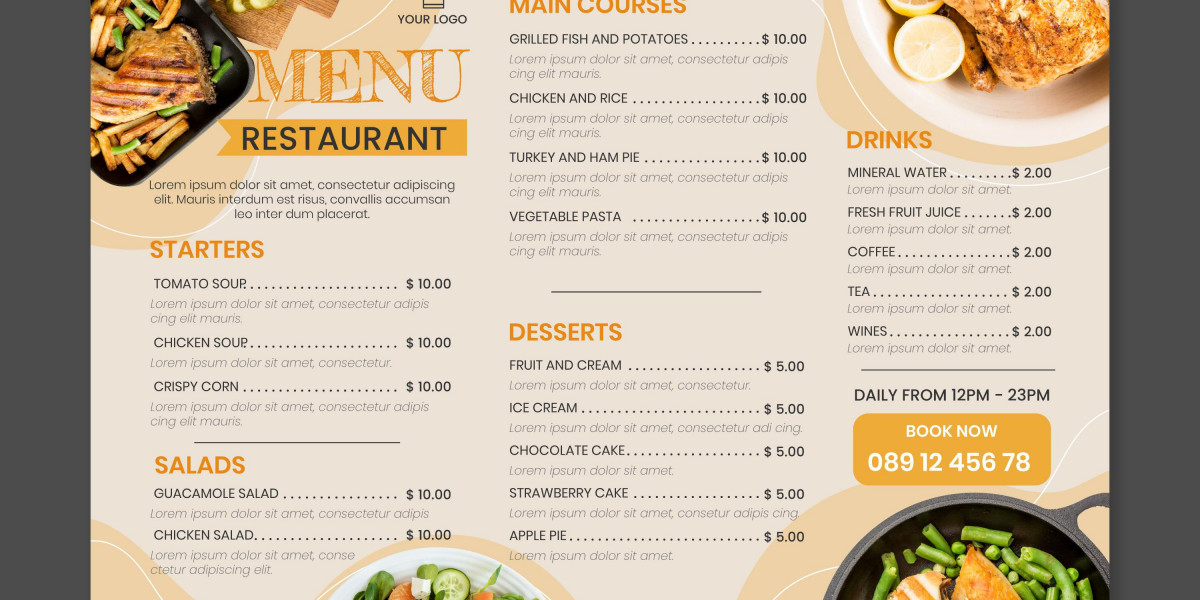The menu is more than just a list of dishes; it is a strategic document that communicates the brand, influences customer choices, and drives profitability. Periodic updates and thoughtful redesigns are essential to keep your offerings fresh and your guests engaged. This article delves into best practices for menu revisions and redesigns, focusing on how restaurant menu design can enhance the dining experience and boost business performance.
The Importance of Menu Updates
Customer preferences evolve, ingredients become more or less available, and food trends come and go. In this dynamic landscape, sticking with the same menu for too long can make a restaurant appear outdated. Menu updates help maintain relevance, accommodate changing costs, and maximize profits.
A revised menu can reflect seasonality, integrate feedback, and introduce new dishes that excite returning guests. Moreover, an updated menu offers an opportunity to highlight high-margin items, eliminate underperformers, and reinforce brand identity. By incorporating strategic restaurant menu design principles, updates can also guide customer behavior and enhance their overall experience.
When to Consider a Menu Revision
There is no one-size-fits-all timeline for revising a menu, but certain signs indicate it might be time:
Sales of certain items are consistently low
Customer feedback indicates dissatisfaction or confusion
Food costs have changed significantly
New culinary trends are emerging in your market
Seasonal ingredients are available or going out of season
You are rebranding or undergoing a visual refresh
Many restaurants choose to revise their menus quarterly or bi-annually, aligning updates with seasonal changes. However, regular review sessions—even monthly—can help track performance and catch issues early.
Analyzing Menu Performance
Before making changes, it’s crucial to understand how your current menu is performing. Menu engineering involves analyzing sales data and profit margins to categorize items into four groups:
Stars – High popularity, high profit. These are your best sellers.
Plow Horses – High popularity, low profit. Consider price adjustments or portion control.
Puzzles – Low popularity, high profit. These may need better placement or description.
Dogs – Low popularity, low profit. These are prime candidates for removal.
This data-driven approach ensures that decisions are based on facts rather than assumptions. It also sets a clear foundation for what should stay, go, or be promoted.
Designing for Customer Psychology
Once you know what changes you want to make, the next step is optimizing the restaurant menu design. The way items are presented influences purchasing decisions. Thoughtful layout, typography, colors, and item descriptions can elevate the customer experience and increase average order value.
Here are key psychological principles to apply:
Menu Scanning Patterns: Diners typically scan a menu in a Z-pattern or Golden Triangle (top-right corner gets the most attention). Place your high-margin items accordingly.
Descriptive Language: Use evocative words to describe flavors, origins, or preparation methods. This can increase sales by creating an emotional connection.
Limiting Choices: Too many options can lead to decision fatigue. Aim for 6–8 items per category to keep the menu digestible.
Anchoring Prices: Place a high-priced item at the top of the category to make the rest of the items feel more affordable.
Visual Hierarchy: Use boxes, borders, or different font styles to highlight certain dishes without cluttering the design.
Effective restaurant menu design is both an art and a science. A well-designed menu supports your brand, enhances the customer experience, and subtly steers choices in your favor.
Seasonal and Limited-Time Offerings
Seasonal menus and limited-time offers (LTOs) are a great way to introduce variety and urgency. They can showcase fresh ingredients, capitalize on holidays, or test new dishes before a full launch.
When integrating these offerings into your main menu, consider using inserts, table tents, or separate handouts. This prevents the main menu from becoming cluttered while drawing attention to the specials. Restaurant menu design for seasonal inserts should maintain brand consistency while offering a fresh visual cue that something new and exciting is available.
Menu Redesign Tips
A redesign goes beyond updating the items—it reimagines the entire look and feel of the menu. Whether you’re aiming for a modern, minimalist look or a vintage, handwritten style, your menu design should reflect your brand personality.
Here are some best practices for menu redesign:
Brand Alignment: Fonts, colors, and layout should align with your restaurant’s theme. A rustic bistro should look different from a sleek sushi bar.
Readability: Ensure font size and contrast are accessible. Customers should not have to squint or guess what they’re reading.
Consistent Formatting: Keep formatting uniform across sections. Misaligned prices or inconsistent spacing can be distracting.
Balanced Layout: Avoid overwhelming one side of the menu. Distribute content evenly and leave enough white space.
High-Quality Imagery: If using photos, ensure they are professional and mouth-watering. Avoid overuse to prevent a diner-style look unless that fits your brand.
Digital menus (on tablets or QR codes) offer even more flexibility. You can rotate items frequently, add engaging visuals, and track customer behavior in real-time. If using digital formats, the principles of restaurant menu design still apply—clean layout, intuitive navigation, and high-quality visuals.
Staff Involvement and Training
Any menu update or redesign should include your staff. Servers, bartenders, and kitchen staff are on the front lines and can provide valuable insights into what works and what doesn’t. They also need to be thoroughly trained on any new items, including ingredients, preparation methods, and recommended pairings.
A confident staff that understands the menu can upsell effectively, answer customer questions with ease, and contribute to a better dining experience. Consider holding tasting sessions and creating cheat sheets to help staff internalize changes quickly.
Testing and Feedback Loops
Don’t launch a new menu in a vacuum. Test changes with a small group or during off-peak times. Solicit feedback from both customers and staff, and be willing to adjust if something doesn’t resonate.
You can also use A/B testing to compare two versions of a menu and see which performs better. For example, you might try different descriptions or pricing formats and track which yields higher sales.
Online feedback, reviews, and comment cards are other valuable sources of information. Incorporate feedback into your ongoing review process so you’re always refining and improving.
Marketing Your New Menu
A revised or redesigned menu is newsworthy—so treat it like an event. Use email newsletters, social media, and in-store signage to promote the update. Tease new dishes, highlight chef favorites, and share behind-the-scenes looks at the creation process.
For larger redesigns, consider hosting a launch night or tasting event to generate buzz. Engaging your community in the excitement can lead to more foot traffic and word-of-mouth referrals.
Digital platforms like your website, Google listing, and third-party delivery apps should be updated promptly to reflect changes. Consistency across channels is crucial for customer trust.
Cost Considerations
Menu updates and redesigns do involve some investment. You may need to budget for:
Professional restaurant menu design services
Printing or digital menu updates
Staff training
Marketing materials
Ingredient sourcing for new dishes
However, these costs are often outweighed by the benefits of increased sales, better customer satisfaction, and improved operational efficiency. Regular, thoughtful updates can reduce waste, highlight profitable items, and keep your brand fresh and relevant.
Conclusion
Revising and redesigning your menu is not just about adding new dishes—it’s about aligning your offerings with customer expectations, business goals, and evolving trends. When approached strategically, updates can enhance the dining experience, reinforce your brand, and drive measurable growth.
By analyzing performance, applying smart restaurant menu design principles, and involving your staff and customers in the process, you can create a menu that’s both functional and inspirational. It becomes a living document—one that evolves with your restaurant, tells your story, and ultimately, delights your guests.









